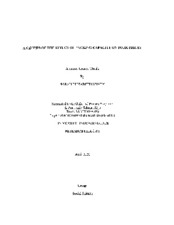| dc.creator | Spivey, Sarah Elizabeth | |
| dc.date.accessioned | 2013-02-22T20:40:02Z | |
| dc.date.available | 2013-02-22T20:40:02Z | |
| dc.date.created | 2000 | |
| dc.date.issued | 2013-02-22 | |
| dc.identifier.uri | https://hdl.handle.net/1969.1/ETD-TAMU-2000-Fellows-Thesis-S686 | |
| dc.description | Due to the character of the original source materials and the nature of batch digitization, quality control issues may be present in this document. Please report any quality issues you encounter to digital@library.tamu.edu, referencing the URI of the item. | en |
| dc.description | Includes bibliographical references (leaves 31-32). | en |
| dc.description.abstract | In 1998, pork prices fell to an all time low. Across the industry, concern was expressed for research as to what led to this price crash. Capacity constraints at the packer level have been a key area of concern. This study is an analysis of the effect of capacity constraints on pork prices. Ordinary least squares (OLS) models were run for both live and cutout prices. Capacity constraints were measured three ways: using a binary variable (0,1 dummy) and two continuous variables. One continuous variable was for the number of head slaughtered on the weekend, and the second continuous variable was found by using a ratio of slaughter during the weekends to slaughter during the 5-day workweek ("over-flow" ratio). The continuous variables used to measure capacity constraints were statistically significant explanatory factors in the regressions for hog and pork prices. The capacity constraints were estimated to have a different relationship with the prices at the farm level as compared with packer prices. Increasing capacity constraints is associated with a negative relationship to farm prices, and a positive relationship to packer prices. The measurement used for over-flow ratio, the ratio of weekend slaughter to slaughter during the 5-day workweek, did not generate different results than the continuous variable of weekend slaughter. The estimated coefficients for both continuous variables were more statistically significant than a dummy variable approach for the capacity constraint. | en |
| dc.format.medium | electronic | en |
| dc.format.mimetype | application/pdf | |
| dc.language.iso | en_US | |
| dc.publisher | Texas A&M University | |
| dc.rights | This thesis was part of a retrospective digitization project authorized by the Texas A&M University Libraries in 2008. Copyright remains vested with the author(s). It is the user's responsibility to secure permission from the copyright holder(s) for re-use of the work beyond the provision of Fair Use. | en |
| dc.subject | social science. | en |
| dc.subject | Major social science. | en |
| dc.title | Analysis of the effect of packing capacity on pork prices | en |
| thesis.degree.department | social science | en |
| thesis.degree.discipline | social science | en |
| thesis.degree.name | Fellows Thesis | en |
| thesis.degree.level | Undergraduate | en |
| dc.type.genre | thesis | en |
| dc.type.material | text | en |
| dc.format.digitalOrigin | reformatted digital | en |


